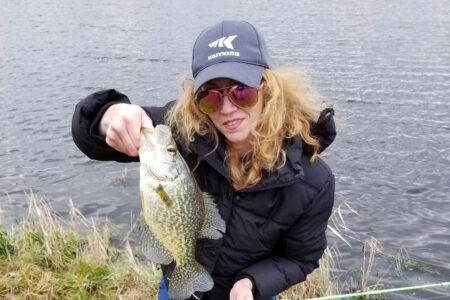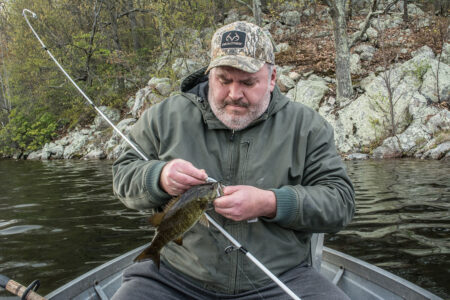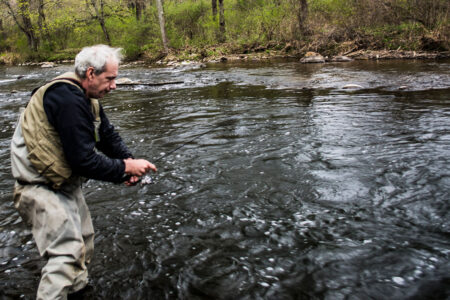Early and late, topwater baits draw strikes from shallow bass.
Topwater plugs are the early and late bite’s mainstay. If I’m out at first light, long before sunrise, I’ve got a topwater plug ready to go, and likewise, if I’ve been fishing a plastic worm through the late day bite, after sunset I’m at least thinking of a plug. Once dusk deepens, I’m using one.
My son and I have a long history of catching bass and pickerel on plugs beginning an hour or so before sunset. We fish a shallow, weedy lake where we would begin perhaps with Heddon Crazy Crawlers. A great search-and-find plug. You reel it back steadily. It creates splashes and a wake with such a commanding presence, we found it effective, even in choppy water. Then, if the surface calmed and shadows deepened, we would begin popping, still covering a lot of water but not as quickly.

The trick to topwater is an internal one. Ultimately, you need to feel confident about where you’re putting the plug. Search-and-find is only an initial step. When things get quiet, you should be sure you’re on fish you can tease out. The bite has slowed. The bass were slamming Pop-R’s retrieved at a clip, and now nothing’s happening.
Mike Maxwell and I once fished a lake with some depth all afternoon for three bass. Mike wanted to go home, but shortly after sunset, I clocked the electric motor up to full speed and hustled to a wide, cove-like corner with shallows and weeds. I switched off the motor and let the squareback ease forward. All was silent. The weeds ahead of us thick, I allowed my eyes to absorb the scene. I wasn’t looking for anything special. I don’t think I was conscious of looking for anything. My single intent all day while on the water is to simply pay attention. I saw the surface bulge about 20 yards ahead of us. Mike saw it, too, but Mike was done. I put my popper in the pocket right in front of the disturbance, and a 19-incher gobbled it.
That’s an easy way to feel confident about the location of a bass, but having caught one, I was ready for more, catching two over 2 pounds minutes later. In general, if you have weeds and some depth nearby, you can count on bass. If the lake is shallow, you just need weeds. If there are none, look for any timber or fish shallow flats and shorelines.
You move as you fish. Trying different pockets and edges. Blooping the plug over the top of weeds underneath. Placing the plug against shoreline structure. But when it gets quiet, if you move too fast, bass might ignore what you toss them.

Throughout the early and late bites, light is either intensifying or decreasing. The eyes of bass have evolved to see prey especially well in these periods of heightening or lessening light. So long as the water is clear enough, bass in the vicinity of a plug will know it’s there. You don’t have to overwork it to get their attention. Teasing them by letting a plug sit long after the cast, and then barely moving that plug, is a matter of form. I don’t know how to explain it otherwise. The whole environment is still, so working the plug quietly fits in with everything else and draws bass to it, rather than turns them away.
I try to make a plug come alive, finding that I’m better at doing that sometimes rather than another. It has to do with exciting my nerves in a way that’s not erratic but true to life. As if I’m the prey. I have experienced some very fast action deep into the dusk when bass have smelled my blood. When the electric life of my nerves works the rod, the result is a lifelike plug. But as I say, you might not want to impart much action, while imaging a reluctant bass sitting right behind. Let that plug draw the fish forward to suck it under.



